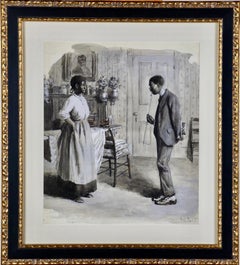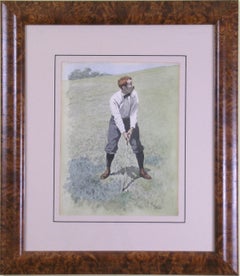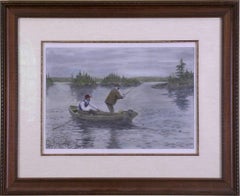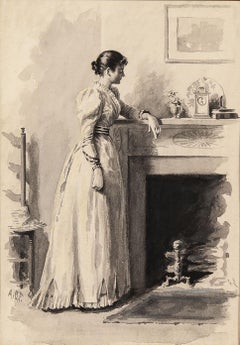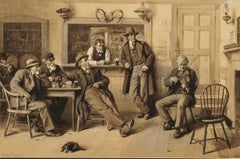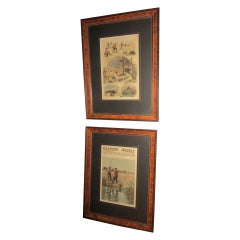Arthur Burdett Frost
American, 1851-1928
A famous illustrator and sporting artist, Arthur B. Frost is perhaps best known for his illustrations for the Uncle Remus tales by Joel Chandler Harris, as well as for naturalistic hunting and shooting prints. Many consider him to be the best illustrator of rural America.
An ardent sportsman himself, many of Frosts favorite subjects were hunting, fishing, and golfing. Often his golfing subjects tended towards humor. His scenes capture the drama of the sport - a hunter poised to shoot and a dog on point - with elements often integrated into a richly detailed woodland or marsh setting.
Frost chronicled aspects of America's cultural life for over five decades. From the late 19th to the early 20th centuries, his art appeared in the many books and publications of the time, including Harper's Weekly, Scribner's, and Life magazines.
Frost's illustrations always evoked the essence of a setting and its mood, whether depicting the hilarious escapades of the family cat or farm dog, or the serene pastoral lifestyle of the native northeast. His sound draftsmanship was combined with an intimate knowledge of nature. Frosts details in his pictures were very specific, as though drawn on the spot, and done in a very convincing manner. In the preface and dedication by Harris of his book Uncle Remus, Harris wrote of Frost "you have conveyed into their quaint antics the illumination of your own inimitable humor, which is as true to our sun and soil as it is to the spirit and essence of the matter. The book was mine, but now you have made it yours, both sap and pith" Other well known examples of Frosts illustrations are Brer Fox and Brer Rabbit from The Tar Baby.
Frost was known to have spent time in the art colony of Rockport, on the Eastern Shore of Cape Ann, Massachusetts, where he is said to have gone because of painter Gilbert Tucker Margeson.
He also summered at the noted Shinnecock Hills Summer School of Art, which William Merritt Chase set up a few miles west of Southampton, New York. Shinnecock Hills became the best known of all the out-of-doors summer art schools that developed in America during the late nineteenth century, and attracted hundreds of aspiring young men and women, including Frost, Rockwell Kent, Lydia Field Emmet, and many others.
Frost was red-green color blind, but it was not a great handicap since the majority of his work was reproduced in black and white. He managed to work successfully in color by reading the labels on the tubes and placing the colors in the proper order on his palette.
Arthur Frost is the father of impressionist painter John Frost (b. 1890 in Philadelphia - 1937), and as a young man John studied art with his father before going on to study in Europe.(Biography provided by Lincoln Glenn)
to
8
5
4
3
3
1
1
1
Workers Loading Freight Train
By Arthur Burdett Frost
Located in Fort Washington, PA
Image of workers loading barrels in a train yard.
Signed Lower Left.
Arthur Burdett Frost was our best illustrator of rural America. He usually treated his characters with humor, and in his drawings there was a directness and honesty which showed his sympathetic understanding of his subjects. His sound draughtsmanship was combined with an intimate knowledge of nature. The details in his pictures are always very specific, as though drawn on the spot, and so artfully chosen and placed as to carry out the picture’s idea in a natural and entirely convincing manner.
He may be best remembered now, however, for his charming illustrations for the Uncle Remus...
Category
Early 1900s Other Art Style Arthur Burdett Frost
Materials
Gouache, Watercolor
"As Long as You's Single Dere's Hope" Scribner's Magazine, 1915
By Arthur Burdett Frost
Located in Fort Washington, PA
Signed "A. B. Frost" Lower Right by Artist
"Jes tak' yo coat off, end dem collars end cuffs, end go out in de yard end cut de grass." Illustration for "As Long as You's Single Dere'...
Category
1910s Arthur Burdett Frost
Materials
Ink
Fore
By Arthur Burdett Frost
Located in Florham Park, NJ
ARTHUR BURDETT FROST
Harper’s Weekly
Harper & Brothers
New York, 1904
Hand-colored Halftone
A.B. Frost, as he was to become known professionally, was born in Philadelphia in 1851. His early years were spent as a student with Thomas Eakins at the Pennsylvania Academy of the Fine Arts. He was to go on as the primary illustrator of more than one hundred published books. Among the notable authors whose works he illustrated were Lewis Carroll, Charles Dickens, Joel Chandler Harris, Mark Twain, Theodore Roosevelt, William Thackeray and others. For nearly fifty continuous years his illustrations appeared in the leading magazines, including Harper's, Scribner's, Collier's, Century, Puck and Life. His own books--Stuff & Nonsense, The Bull Calf and Other Tales, and Carlo--were recognized as masterpieces of comedy. As a painter in oil, Frost exhibited in both the United States and abroad. The unforgettable Brer Rabbit...
Category
Early 1900s Academic Arthur Burdett Frost
Materials
Lithograph
"Got 'Em" (Lake Fishing)
By Arthur Burdett Frost
Located in Florham Park, NJ
ARTHUR BURDETT FROST
A Book of Drawings
Collier and Sons
New York, 1904
Hand-colored Halftone
A.B. Frost, as he was to become known professionally, was born in Philadelphia...
Category
Early 1900s American Realist Arthur Burdett Frost
Materials
Watercolor, Lithograph
Waiting by the Hearth
By Arthur Burdett Frost
Located in Fort Washington, PA
Signed Lower Left
The handwritten card on the back of the frame states that this picture is an illustration for "The Squirrel Inn" by Frank R. Stocktonn which appeared in The Centur...
Category
19th Century Arthur Burdett Frost
Materials
Paper, Ink
The Itinerant Fiddler
By Arthur Burdett Frost
Located in Fort Washington, PA
Date: 1890
Medium: Watercolor en Grisaille
Dimensions: 18.00" x 26.75"
Signature: Signed Lower Left
Editorial illustration, image of a man playing a violin with other men looking on...
Category
1890s Arthur Burdett Frost
Materials
Watercolor
Men Reading the Newspaper
By Arthur Burdett Frost
Located in Fort Washington, PA
Story illustration, image of a man reading the newspaper surrounded by other men.
Arthur Burdett Frost was our best illustrator of rural Ameri...
Category
19th Century Other Art Style Arthur Burdett Frost
Materials
Watercolor
The Peg Legged Man
By Arthur Burdett Frost
Located in Fort Washington, PA
The Peg Legged Man
Arthur Burdett Frost was our best illustrator of rural America. He usually treated his characters with humor, and in his drawings there was a directness and honesty which showed his sympathetic understanding of his subjects. His sound draughtsmanship was combined with an intimate knowledge of nature. The details in his pictures are always very specific, as though drawn on the spot, and so artfully chosen and placed as to carry out the picture’s idea in a natural and entirely convincing manner.
He may be best remembered now, however, for his charming illustrations for the Uncle Remus...
Category
20th Century Other Art Style Arthur Burdett Frost
Materials
Paper, Pen, Pencil
Related Items
The Abduction of the Sabine Women , a Renaissance drawing by Biagio Pupini
Located in PARIS, FR
This vigorous drawing has long been attributed to Polidoro da Caravaggio: The Abduction of the Sabine Women is one of the scenes that Polidoro depicted between 1525 and 1527 on the façade of the Milesi Palazzo in Rome. However, the proximity to another drawing inspired by this same façade, kept at the Ecole des Beaux-Arts, and to other drawings inspired by Polidoro kept at the Musée du Louvre, leads us to propose an attribution to Biagio Pupini, a Bolognese artist whose life remains barely known, despite the abundant number of drawings attributed to him.
1. Biagio Pupini, a Bolognese artist in the light of the Roman Renaissance
The early life of Biagio Pupini, an important figure of the first half of the Cinquecento in Bologna - Vasari mentions him several times - is still poorly known. Neither his date of birth (probably around 1490-1495) nor his training are known. He is said to have been a pupil of Francesco Francia (1450 - 1517) and his name appears for the first time in 1511 in a contract with the painter Bagnacavallo (c. 1484 - 1542) for the frescoes of a church in Faenza. He then collaborated with Girolamo da Carpi, at San Michele in Bosco and at the villa of Belriguardo.
He must have gone to Rome for the first time with Bagnacavallo between 1511 and 1519. There he discovered the art of Raphael, with whom he might have worked, and that of Polidoro da Caravaggio. This first visit, and those that followed, were the occasion for an intense study of ancient and modern art, as illustrated by his abundant graphic production.
Polidoro da Caravaggio had a particular influence on the technique adopted by Pupini. Executed on coloured paper, his drawings generally combine pen, brown ink and wash with abundant highlights of white gouache, as in the drawing presented here.
2. The Abduction of the Sabine Women
Our drawing is an adaptation of a fresco painted between 1525 and 1527 by Polidoro da Caravaggio on the façade of the Milesi Palace in Rome. These painted façades were very famous from the moment they were painted and inspired many artists during their stay in Rome. These frescoes are now very deteriorated and difficult to see, as the palace is in a rather narrow street.
The episode of the abduction of the Sabine women (which appears in the centre of the photo above) is a historical theme that goes back to the origins of Rome and is recounted both by Titus Livius (Ab Urbe condita I,13), by Ovid (Fasti III, 199-228) and by Plutarch (II, Romulus 14-19). After killing his twin brother Romus, Romulus populates the city of Rome by opening it up to refugees and brigands and finds himself with an excess of men. Because of their reputation, none of the inhabitants of the neighbouring cities want to give them their daughters in marriage. The Romans then decide to invite their Sabine neighbours to a great feast during which they slaughter the Sabines and kidnap their daughters.
The engraving made by Giovanni Battista Gallestruzzi (1618 - 1677) around 1656-1658 gives us a good understanding of the Polidoro fresco, allowing us to see how Biagio Pupini reworked the scene to extract this dynamic group.
With a remarkable economy of means, Biagio Pupini takes over the left-hand side of the fresco and depicts in a very dense space two main groups, each consisting of a Roman and a Sabine, completed by a group of three soldiers in the background (which seems to differ quite significantly from Polidoro's composition).
The balance of the drawing is based on a very strongly structured composition. The drawing is organised around a median vertical axis, which runs along both the elbow of the kidnapped Sabine on the left and the foot of her captor, and the two main diagonals, reinforced by four secondary diagonals. This diamond-shaped structure creates an extremely dynamic space, in which centripetal movements (the legs of the Sabine on the right, the arm of the soldier on the back at the top right) and centrifugal movements (the arm of the kidnapper on the left and the legs of the Sabine he is carrying away, the arm of the Sabine on the right) oppose each other, giving the drawing the appearance of a whirlpool around a central point of support situated slightly to the left of the navel of the kidnapper on the right.
3. Polidoro da Caravaggio, and the decorations of Roman palaces
Polidoro da Caravaggio was a paradoxical artist who entered Raphael's (1483 - 1520) workshop at a very young age, when he oversaw the Lodges in the Vatican. Most of his Roman work, which was the peak of his career, has disappeared, as he specialised in facade painting, and yet these paintings, which are eminently visible in urban spaces, have influenced generations of artists who copied them abundantly during their visits to Rome.
Polidoro Caldara was born in Caravaggio around 1495-1500 (the birthplace of Michelangelo Merisi, known as Caravaggio, who was born there in 1571), some forty kilometres east of Milan. According to Vasari, he arrived as a mason on the Vatican's construction site and joined Raphael's workshop around 1517 (at the age of eighteen according to Vasari). This integration would have allowed Polidoro to work not only on the frescoes of the Lodges, but also on some of the frescoes of the Chambers, as well as on the flat of Cardinal Bibiena in the Vatican.
After Raphael's death in 1520, Polidoro worked first with Perin del Vaga before joining forces with Maturino of Florence (1490 - 1528), whom he had also known in Raphael's workshop. Together they specialised in the painting of palace façades. They were to produce some forty façades decorated with grisaille paintings imitating antique bas-reliefs.
The Sack of Rome in 1527, during which his friend Maturino was killed, led Polidoro to flee first to Naples (where he had already stayed in 1523), then to Messina. It was while he was preparing his return to the peninsula that he was murdered by one of his assistants, Tonno Calabrese, in 1543.
In his Vite, Vasari celebrated Polidoro as the greatest façade decorator of his time, noting that "there is no flat, palace, garden or villa in Rome that does not contain a work by Polidoro". Polidoro's facade decorations, most of which have disappeared as they were displayed in the open air, constitute the most important lost chapter of Roman art of the Cinquecento. The few surviving drawings of the painter can, however, give an idea of the original appearance of his murals and show that he was an artist of remarkable and highly original genius.
4. The façade of the Milesi Palace
Giovanni Antonio Milesi, who commissioned this palace, located not far from the Tiber, north of Piazza Navona, was a native of the Bergamo area, like Polidoro, with whom he maintained close friendly ties. Executed in the last years before the Sack of Rome, around 1526-1527, the decoration of Palazzo Milesi is considered Polidoro's greatest decorative success.
An engraving by Ernesto Maccari made at the end of the nineteenth century allows us to understand the general balance of this façade, which was still well preserved at the time. The frescoes were not entirely monochrome, but alternated elements in chiaroscuro simulating marble bas-reliefs and those in ochre simulating bronze and gold vases...
Category
16th Century Old Masters Arthur Burdett Frost
Materials
Ink, Gouache, Pen
Meditation and Minou
By Will Barnet
Located in Buffalo, NY
Artist: Will Barnet, American (1911 - 2012)
Title: Meditation and Minou
Year: 1980
Medium: Lithograph and Serigraph on BFK Rives, signed and numbered in pencil
Edition: 40/150
Category
1970s American Realist Arthur Burdett Frost
Materials
Archival Paper, Lithograph
Lee Hurst (3/4 Figure, Hands Together), Mixed media on Pergamenata parchment
By Howard Tangye
Located in London, GB
Howard Tangye (b.1948, Australia) has been an influential force in fashion for decades. Lecturing at London’s Central Saint Martins for 35 years, including 16 years as head of BA Wom...
Category
2010s Contemporary Arthur Burdett Frost
Materials
Paint, Paper, Parchment Paper, Charcoal, Crayon, Oil Crayon, Oil Pastel,...
Balmoral - Signed Lithograph, Royal Art, Royal Homes, Balmoral Castle, British
By Charles (Prince of Wales)
Located in Knowle Lane, Cranleigh
Balmoral by His Majesty King Charles III (formerly known as HRH Prince Charles, The Prince of Wales) - Hand Signed Limited Edition Lithograph.
Belgravia Gallery has been honoured to be associated with the artworks of HRH The Prince of Wales for over 25 years. Anna Hunter, gallery owner, wrote a handwritten letter to the Prince asking him if he would consider making signed lithographs from his beautiful watercolours which could
be sold in aid of his charities. The gallery subsequently worked with the Prince for over 10 years publishing some 18 different editions and raising over £4million for the Prince’s Charitable Foundation.
Lithographs were made from the Prince’s original watercolours under the guidance of Stanley Jones – a celebrated printmaker who had previously worked with Henry Moore for 30 years, and with Elizabeth Frink, David Hockney and others. Each one is hand-signed.
“…One thing I have discovered in the course of my painting efforts is that Balmoral Castle...
Category
1990s Academic Arthur Burdett Frost
Materials
Lithograph
H 18.12 in W 24.02 in D 1.58 in
To Childhood Illnesses from the Rilke Portfolio
By Ben Shahn
Located in Mount Vernon, NY
The Rilke Portfolio by Ben Shahn contained 24 prints from the Atelier Mourlot in New York. The Munn Collection offers 7 unframed lithographs from the o...
Category
1960s American Realist Arthur Burdett Frost
Materials
Lithograph
Red Rose - contemporary work by award winning emerging artist Fujiko Rose
Located in London, GB
Fujiko’s work amalgamates a contrast of the contemporary with traditional scenes, juxtaposing Indian black ink on a variety of warm textured papers, whilst forming a modern emotive f...
Category
21st Century and Contemporary Contemporary Arthur Burdett Frost
Materials
India Ink
H 27.5 in W 19.5 in D 0.5 in
Freya (Seated Backwards), Mixed media on grey board
By Howard Tangye
Located in London, GB
Howard Tangye (b.1948, Australia) has been an influential force in fashion for decades. Lecturing at London’s Central Saint Martins for 35 years, including 16 years as head of BA Wom...
Category
2010s Contemporary Arthur Burdett Frost
Materials
Other Medium, Archival Paper, Handmade Paper, Pen, Felt Pen, Permanent M...
Partings Long Seen Coming from the Rilke Portfolio
By Ben Shahn
Located in Mount Vernon, NY
The Rilke Portfolio by Ben Shahn contained 24 prints from the Atelier Mourlot in New York. The Munn Collection offers 7 unframed lithographs from the o...
Category
1960s American Realist Arthur Burdett Frost
Materials
Lithograph
Hunting Leopard
Located in Sydney, NSW
19th Century chromolithograph of a Hunting Leopard
Category
19th Century Academic Arthur Burdett Frost
Materials
Lithograph
"Les Rois de Legendes #24 Musicien" The Kings Of Legend #24 Musician
Located in Berlin, MD
Erte (Romain de Tirtoff) Russian/French 1892-1990. "Les Rois de Legendes #24 Musicien" The Kings Of Legend #24 Musician. A beautiful, original gouache and ink piece (this is not a ...
Category
Early 20th Century Art Deco Arthur Burdett Frost
Materials
Ink, Gouache
Waterfront
By Raphael Soyer
Located in Raleigh, NC
Excellent condition and matted with archival materials.
An excellent addition to any New York or WPA collection.
Category
1930s American Realist Arthur Burdett Frost
Materials
Lithograph
Untitled (Study for Līnea)
Located in Washington, DC
Poured beeswax work by Mary Early from her "Study for Līnea" series.
"The production, or “pouring,” of beeswax elements has become a meditative process that is integral to my art practice, serving as an observation of time, materials, and space. The raw beeswax I use has taken its form at the end of a long series of natural processes followed by a manufacturing process, and once it is in my hands, the studio becomes a factory. I apply my own methods of transforming the material by casting the beeswax into three-dimensional forms. Once I have fixed both a place and a time in the future for a potential installation, I begin to determine how the beeswax lines will take their aggregated shape in that space and, simultaneously, how many lines might be manufactured for that particular space in the amount of time available."
Mary Early (born 1975, Washington, DC) lives and works in Washington, DC. She studied visual art, film, and video at Bennington College, and her work has been exhibited at the United States Botanic Garden, Washington Project for the Arts, the Corcoran Gallery of Art, Second Street Gallery (Charlottesville, VA), Hemphill Fine Arts (Washington DC,) the Austrian Cultural Forum (Washington DC), Galerie Im Ersten (Vienna, Austria), Kloster Schloss Salem (Salem, Germany), Kunstlerbund Tubingen (Tubingen, Germany), and the American University Museum (Washington DC) among other regional and national galleries.
Her early work incorporated formed concrete, tarpaper and paraffin wax, fabricated wood structures, and, increasingly over the years, surfaces coated with wax as a method of preserving or concealing an object within. Recent works have relied solely on solid forms cast in wax, abandoning the use of any permanent armature. Temporary installations are guided by schematic drawings and plans, which then serve as a permanent record.
In 2014 she exhibited her first large-scale installation of wax lines at Second Street Gallery in Charlottesville, VA, followed by temporary installations in response to various historical sites in Salem, Germany (2016) and Tubingen Germany (2017). In 2017 she participated in the exhibition “Twist-Layer-Pour” at the American University Museum, which included Untitled [Curve], an installation of thousands of beeswax lines assembled on the floor of the museum. In spring 2018 she was commissioned to create a temporary installation at the Sun Valley Center for the Arts, Sun Valley Idaho. This work took the form of two intersecting curtains of hanging beeswax lines bisecting a 12’ foot x 18’ foot room, providing an immersive and enclosed viewing space.
Early’s work is included in the collections of the US Department of State/Embassy of Panama, Kimpton Hotels, and the District of Columbia Art Bank among other public and private collections. She is a recipient of the Artist Fellowship Grant from the DC Commission on Arts & Humanities, Washington DC (2020, 2019, 2018, 2017, 2016, 2015, 2014, 2011, 2009, 2007).
Early is the director of HEMPHILL Fine Arts, Washington, DC, and serves on the boards of Hamiltonian Artists and Washington Sculptors Group. She handles the work of contemporary artists and artist estates, including the work of William Christenberry, Colby Caldwell, Hedieh Javanshir Ilchi, Linling Lu, Mingering Mike, Robin Rose, Renée Stout...
Category
21st Century and Contemporary Abstract Geometric Arthur Burdett Frost
Materials
Wax Crayon, Sumi Ink, Archival Paper, Graphite
Previously Available Items
19th C Harper's Weekly A.B. Frost Sporting Prints with Burled Walnut Frames
By Arthur Burdett Frost
Located in Savannah, GA
Beautifully framed in burled walnut with French matting scored in a thin outline of gold, these handsome sporting prints are by Arthur Burdett Frost and featured in Harper's Weekly m...
Category
Late 19th Century American Victorian Antique Arthur Burdett Frost
Materials
Glass, Walnut, Paper
H 19.5 in W 25.25 in D 1 in
"Cottage in Giverny, France, " Arthur Burdett Frost, Antique French Landscape
By Arthur Burdett Frost
Located in New York, NY
Arthur Burdett Frost (1851 - 1928)
Cottage in Giverny, France, circa 1910
Oil on canvas
16 1/2 x 13 1/2
Signed lower right
A famous illustrator and sporting artist, Arthur B. Frost is perhaps best known for his illustrations for the Uncle Remus tales by Joel Chandler Harris, as well as for naturalistic hunting and shooting prints. Many consider him to be the best illustrator of rural America.
An ardent sportsman himself, many of Frosts favorite subjects were hunting, fishing, and golfing. Often his golfing subjects tended towards humor. His scenes capture the drama of the sport - a hunter poised to shoot and a dog on point - with elements often integrated into a richly detailed woodland or marsh setting.
Frost chronicled aspects of America's cultural life for over five decades. From the late 19th to the early 20th centuries, his art appeared in the many books and publications of the time, including Harper's Weekly, Scribner's, and Life magazines.
Frost's illustrations always evoked the essence of a setting and its mood, whether depicting the hilarious escapades of the family cat or farm dog, or the serene pastoral lifestyle of the native northeast. His sound draftsmanship was combined with an intimate knowledge of nature. Frosts details in his pictures were very specific, as though drawn on the spot, and done in a very convincing manner. In the preface and dedication by Harris of his book Uncle Remus, Harris wrote of Frost "you have conveyed into their quaint antics the illumination of your own inimitable humor, which is as true to our sun and soil as it is to the spirit and essence of the matter. The book was mine, but now you have made it yours, both sap and pith" Other well known examples of Frosts illustrations are Brer Fox and Brer Rabbit from The Tar Baby.
Frost was known to have spent time in the art colony of Rockport, on the Eastern Shore of Cape Ann, Massachusetts, where he is said to have gone because of painter Gilbert Tucker Margeson.
He also summered at the noted Shinnecock Hills...
Category
1910s American Impressionist Arthur Burdett Frost
Materials
Canvas, Oil
Ice Skating
By Arthur Burdett Frost
Located in Florham Park, NJ
ARTHUR BURDETT FROST
Harper’s Weekly
Harper & Brothers
New York, 1904
Hand-colored Halftone
A.B. Frost, as he was to become known professionally, was born in Philadelphia in 1851. His early years were spent as a student with Thomas Eakins at the Pennsylvania Academy of the Fine Arts. He was to go on as the primary illustrator of more than one hundred published books. Among the notable authors whose works he illustrated were Lewis Carroll, Charles Dickens, Joel Chandler Harris, Mark Twain, Theodore Roosevelt, William Thackeray and others. For nearly fifty continuous years his illustrations appeared in the leading magazines, including Harper's, Scribner's, Collier's, Century, Puck and Life. His own books--Stuff & Nonsense, The Bull Calf and Other Tales, and Carlo--were recognized as masterpieces of comedy. As a painter in oil, Frost exhibited in both the United States and abroad. The unforgettable Brer Rabbit...
Category
Early 1900s Academic Arthur Burdett Frost
Materials
Lithograph
Possibly by Arthur B. Frost, Illustration of Hunter with Dogs
By Arthur Burdett Frost
Located in Hallowell, ME
14" x 20" oil on canvas, placed in a good reproduction arts and crafts frame. Inscribed at a later date on the stretcher " AB Frost, 1910" on the old frame that once held this work. Frost painted many paintings and it is possible this work is authentic. I am playing it safe and saying that it is not by the famous illustrator, AB Frost because the quality is not very high.
A famous illustrator and sporting artist, Arthur B. Frost is perhaps best known for his illustrations for the Uncle Remus tales by Joel Chandler Harris, as well as for naturalistic hunting and shooting prints. Many consider him to be the best illustrator of rural America.
An ardent sportsman himself, many of Frosts favorite subjects were hunting, fishing, and golfing. Often his golfing subjects tended towards humor. His scenes capture the drama of the sport - a hunter poised to shoot and a dog on point - with elements often integrated into a richly detailed woodland or marsh setting.
Frost chronicled aspects of America's cultural life for over five decades. From the late 19th to the early 20th centuries, his art appeared in the many books and publications of the time, including Harper's Weekly, Scribner's, and Life magazines.
Frost's illustrations always evoked the essence of a setting and its mood, whether depicting the hilarious escapades of the family cat or farm dog...
Category
1910s American Realist Arthur Burdett Frost
Materials
Oil
H 24 in W 27.4 in D 2 in
Football Match Between Yale and Princeton, November 27
By Arthur Burdett Frost
Located in Fairlawn, OH
Designed by A. B. Frost (1851-1928)
Football Match Between Yale and Princeton, November 27
Signed in the block lower right corner
Woodengraving from Harper’s Weekly, December 20, 187...
Category
1870s Realist Arthur Burdett Frost
Materials
Engraving
H 9.125 in W 13.5 in D 8 in
Dried Up
By Arthur Burdett Frost
Located in Fort Washington, PA
Date: 1925
Medium: Graphite on Paper
Dimensions: 13.00" x 20.75"
Signature: Unsigned, Inscribed on the Verso By A B Frost / Priscella Frost / daughter
Category
1920s Arthur Burdett Frost
Materials
Paper, Graphite
19th century Framed Sporting Prints by A.B. Frost Set of Four
By Arthur Burdett Frost
Located in Savannah, GA
Set of four prints; Snipe Shooting- 1898, A Pot Hunter-1884,
A Tempting Shot- 1884, Rail Shooting-1898, from Harper's Weekly, New York, by A.B. Frost. B...
Category
1890s American Other Antique Arthur Burdett Frost
Materials
Glass, Wood, Magazine Paper
A. B. Frost Framed Sporting Print "Caribou Hunting" Harper's Weekly
By Arthur Burdett Frost
Located in Savannah, GA
"Caribou Hunting in the Barren Grounds, New Brunswick" print from Harper's Weekly, New York, January 5, 1884, signed A.B. Frost. Beautifully newly matted and framed in wooden frame.
...
Category
1880s American Other Antique Arthur Burdett Frost
Materials
Glass, Wood, Magazine Paper
Quail Shooting -- An Unexpected Bevy
By Arthur Burdett Frost
Located in Florham Park, NJ
ARTHUR BURDETT FROST
A Book of Drawings
Collier and Sons
New York, 1904
Hand-colored Halftone
A.B. Frost, as he was to become known professionally, was born in Philadelphia...
Category
Early 1900s American Realist Arthur Burdett Frost
Materials
Lithograph, Watercolor
Sand trap.
By Arthur Burdett Frost
Located in Florham Park, NJ
ARTHUR BURDETT FROST
Harper’s Weekly
Harper & Brothers
New York, 1904
Hand-colored Halftone
A.B. Frost, as he was to become known professionally, was born in Philadelphia in ...
Category
Early 1900s Academic Arthur Burdett Frost
Materials
Lithograph
Ladies on the fairway.
By Arthur Burdett Frost
Located in Florham Park, NJ
ARTHUR BURDETT FROST
Harper’s Weekly
Harper & Brothers
New York, 1904
Hand-colored Halftone
A.B. Frost, as he was to become known professionally, was born in Philadelphia in ...
Category
Early 1900s Academic Arthur Burdett Frost
Materials
Lithograph
Playing as if he owed the green.
By Arthur Burdett Frost
Located in Florham Park, NJ
ARTHUR BURDETT FROST
Henry E. Howland "Golf"
Scribners & Sons, 1895
Hand-colored Halftone
A.B. Frost, as he was to become known professionally, was born in Philadelphia in 185...
Category
Late 19th Century Academic Arthur Burdett Frost
Materials
Lithograph
Arthur Burdett Frost art for sale on 1stDibs.
Find a wide variety of authentic Arthur Burdett Frost available for sale on 1stDibs. You can also browse by medium to find art by Arthur Burdett Frost in paint, watercolor, lithograph and more. Not every interior allows for large Arthur Burdett Frost, so small editions measuring 12 inches across are available. Customers who are interested in this artist might also find the work of Yosha Zuko Fuzu, Gaetano Savorelli, and Alexander Pope. Arthur Burdett Frost prices can differ depending upon medium, time period and other attributes. On 1stDibs, the price for these items starts at $350 and tops out at $22,000, while the average work can sell for $2,750.
